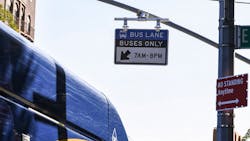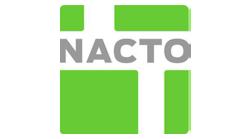Want to reduce emissions and increase transit ridership? NACTO says the answer is to ‘Move! That! Bus!’
The National Association of City Transportation Officials (NACTO) has a three-word recommendation designed to boost transit ridership and reduce transportation impacts on the climate: Move that bus.
In a new report, NACTO makes the case that the “humble city bus” is a powerful tool in the fight against climate change and, with implementation of several tactics included in the report, a transformation can be achieved in two years.
The main takeaway from the report is that policies and infrastructure that support reliable, frequent bus service can offer a solution to get people out of their cars. NACTO includes a few statistics as to why this matters:
- People traveling in private cars, trucks and SUVs make up more than half of transportation emissions in the U.S.; a country where the greatest share of greenhouse gas emissions is from the transportation sector; and
- Less than half of the U.S. population lives within walking distance to transit and less than 10 percent lives within walking distance to transit service frequent enough to make living without a car possible.
“The best climate solution is one that millions of people take every day–the city bus,” said Corinne Kisner, executive director, NACTO. “By implementing the proven bus improvements and policy reforms outlined in our report, cities and transit agencies can reduce greenhouse gas emissions and fight climate change, while simultaneously building more equitable and accessible transportation networks–fast. Leaders at all levels must focus the full weight of their authority on this crucial effort. There is no time to waste.”
The report is aimed at local decision makers because, as NACTO notes, “almost all decisions about bus service are made locally, by local governments and local leaders.” NACTO says national policy cannot move at the speed needed to avert climate change and urged local leaders to take action.
"By acting at the local level, cities have the power to create transformational change on a global scale," said Janette Sadik-Khan, NACTO chair. "High-quality bus service is the foundation for a more sustainable and equitable future. The opportunity is there: local leaders simply have to take it."
The recommendations in the report include:
- Provide frequent, all-day bus service by:
- Shifting existing schedules and resources to increase frequency;
- Redesigning bus networks to expand access to neighborhood jobs and destinations; and
- Investing in more service through:
- Service buy-ups where cities can purchase additional service to boost frequency on specific routes; and/or
- Transit referendums that can provide funding for operations, maintenance and capital projects without the risk of fare increases or service cuts.
- Prioritize bus service by redesigning streets through:
- Dedicated bus lanes;
- Spot treatments such as queue jumps, properly sized bus stops and turn restrictions;
- Transit signal priority;
- Bus stop balancing and upgrades; and
- Safe, accessible connections to bus stops.
- Adopt transit supporting local policy reforms such as:
- Demand-based parking prices that reflect the value to urban curb space;
- Price congestion can disincentivize single occupant vehicle use during peak periods; and
- Adopt zoning and parking reforms to eliminate parking over supply, while supporting housing and mixed use development.
The full report is available on NACTO’s website.

Mischa Wanek-Libman | Group Editorial Director
Mischa Wanek-Libman is director of communications with Transdev North America. She has more than 20 years of experience working in the transportation industry covering construction projects, engineering challenges, transit and rail operations and best practices.
Wanek-Libman has held top editorial positions at freight rail and public transportation business-to-business publications including as editor-in-chief and editorial director of Mass Transit from 2018-2024. She has been recognized for editorial excellence through her individual work, as well as for collaborative content.
She is an active member of the American Public Transportation Association's Marketing and Communications Committee and served 14 years as a Board Observer on the National Railroad Construction and Maintenance Association (NRC) Board of Directors.
She is a graduate of Drake University in Des Moines, Iowa, where she earned a Bachelor of Arts degree in Journalism and Mass Communication.



